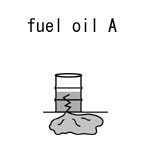| Case Name |
Leakage of fuel oil into the sea from the corroded part under hot insulation of receiving piping at a jetty |
| Pictograph |

|
| Date |
October 11, 1990 |
| Place |
Kawasaki, Kanagawa, Japan |
| Location |
Refinery |
| Overview |
On October 11th, 1990, fuel oil leaked from piping near the jetty during transfer work between tanks at an oil refinery, and it flowed into the sea. The cause is that piping covered with hot insulation was corroded by salt. As corrosion by salt can progress rapidly due to environmental conditions that are not expected, a detailed check has to be carried out with planned replacement. |
| Incident |
Fuel oil leaked from receiving piping of an oil refinery into the sea. AS the pressure of the receiving piping from the jetty to a tank also rose when fuel oil transfer with a pump between tanks started, fuel oil leaked from the corroded part. About 190 L of fuel oil leaked into the sea near the jetty. |
| Processing |
Storage |
| Individual Process |
Transfer |
| Substance |
Fuel oil |
| Type of Accident |
Leakage, environmental pollution |
| Sequence |
06:00 on October 11th, 1990. No abnormality was found at periodic patrol.
09:25. Transfer of fuel oil between tanks started with a pump. At this time, pressure rose at the receiving piping.
09:45. A worker who was near the jetty felt a smell of oil. As the oil leak was found in the sea when he searched near by, the leak was reported to the shipping control room.
09:50. The worker at the control room stopped the pump immediately and closed the related valve. He informed to other sections.
10:10. An oil fence was extended. Processing of spilt oil in the sea was started with an adsorption mat and oil dispersants. Investigation of leakage was conducted.
10:15. The leaking point was covered with an iron. The oil pan was installed and oil was gathered using the pneumatic pump.
12:15. The leak was reported to the fire department by telephone.
15:00. A blind plate was inserted into the flange near the leakage.
17:40. The iron band was removed and the remaining oil was gathered. The iron band was put on again, a check was made, and no leakage was confirmed. |
| Cause |
As waterproofing of hot insulation of the piping was inadequate, sea water invaded. The piping which was not coated with corrosive protection paint corroded. Scale adhered to the piping about a maximum of 10 mm thick, and is regarded to have separated due to the increase in the internal pressure. 30 years had passed since construction of the heat insulation. |
| Response |
Use of an oil fence, an adsorption mat, and oil dispersants. Insertion of a blind plate. A report to a fire station. |
| Countermeasures |
A check method, its cycle, etc. of hot insulated piping are improved.
To prevent delay in the report to a fire fighting station, review of the reporting method and reeducation of an employee were performed.
Even if piping is heat insulated, it is desirable to apply anticorrosive paint. |
| Knowledge Comment |
Corrosion is caused at a place that is not visible and is not noticed.
On the other hand, it can be prevented by careful watch. |
| Background |
Defects in facility management resulting from insufficient information gathering or safety consciousness are considered to be the cause. External corrosion had already become a problem in oil refineries and petrochemical companies in 1990, the time of the accident. This company left it for ten years after a check in 1980. That is, sufficient maintenance was not performed on external corrosion. Conditions where external corrosion tends to take place are given below.
Near the sea. Under hot insulation. The area with no coating. Imperfect waterproofing of heat insulation. Steam traces. Where there is contact with ground. High humidity at any time, etc. |
| Incidental Discussion |
Piping covered by hot insulation is not painted in many cases. However, considering corrosion, probably, at least under coating would be required. As it is very hard to escape from moisture that enters under hot insulation, it is easy to accelerate corrosion. |
| Reason for Adding to DB |
Example of leakage caused due to corrosion of piping under hot insulation |
| Scenario |
| Primary Scenario
|
Poor Value Perception, Poor Safety Awareness, Inadequate Risk Recognition, Insufficient Analysis or Research, Insufficient Environment Study, Sealine and under Hot Insulation, Planning and Design, Poor Planning, Poor Inspection Planning, Usage, Maintenance/Repair, Looseness of Painting/Hot Insulation, Failure, Abrasion, Corrosion, Secondary Damage, External Damage, Leakage, Secondary Damage, Damage to Environment, Sea Pollution
|
|
| Sources |
Kawasaki City Fire fighting station, Prevention division, Peace section, Outline of leakage of dangerous material from fuel oil-receiving piping at oil terminal of G petroleum Co., Ltd. Material of the Kawasaki City Complex safety countermeasure committee.
|
| Physical Damage |
About 190 L of fuel oil leaked. |
| Consequences |
Leakage of oil into the sea near a jetty. |
| Field |
Chemicals and Plants
|
| Author |
ITAGAKI, Haruhiko (Japan National Institute of Occupational Safety and Health)
TAMURA, Masamitsu (Center for Risk Management and Safety Sciences, Yokohama National University)
|